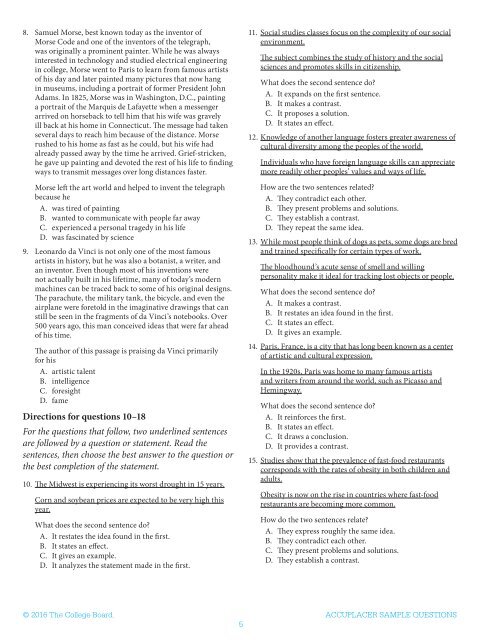ACCUPLACER
2AtxtPzWz
2AtxtPzWz
Create successful ePaper yourself
Turn your PDF publications into a flip-book with our unique Google optimized e-Paper software.
8. Samuel Morse, best known today as the inventor of<br />
Morse Code and one of the inventors of the telegraph,<br />
was originally a prominent painter. While he was always<br />
interested in technology and studied electrical engineering<br />
in college, Morse went to Paris to learn from famous artists<br />
of his day and later painted many pictures that now hang<br />
in museums, including a portrait of former President John<br />
Adams. In 1825, Morse was in Washington, D.C., painting<br />
a portrait of the Marquis de Lafayette when a messenger<br />
arrived on horseback to tell him that his wife was gravely<br />
ill back at his home in Connecticut. The message had taken<br />
several days to reach him because of the distance. Morse<br />
rushed to his home as fast as he could, but his wife had<br />
already passed away by the time he arrived. Grief-stricken,<br />
he gave up painting and devoted the rest of his life to finding<br />
ways to transmit messages over long distances faster.<br />
Morse left the art world and helped to invent the telegraph<br />
because he<br />
A. was tired of painting<br />
B. wanted to communicate with people far away<br />
C. experienced a personal tragedy in his life<br />
D. was fascinated by science<br />
9. Leonardo da Vinci is not only one of the most famous<br />
artists in history, but he was also a botanist, a writer, and<br />
an inventor. Even though most of his inventions were<br />
not actually built in his lifetime, many of today’s modern<br />
machines can be traced back to some of his original designs.<br />
The parachute, the military tank, the bicycle, and even the<br />
airplane were foretold in the imaginative drawings that can<br />
still be seen in the fragments of da Vinci’s notebooks. Over<br />
500 years ago, this man conceived ideas that were far ahead<br />
of his time.<br />
The author of this passage is praising da Vinci primarily<br />
for his<br />
A. artistic talent<br />
B. intelligence<br />
C. foresight<br />
D. fame<br />
Directions for questions 10–18<br />
For the questions that follow, two underlined sentences<br />
are followed by a question or statement. Read the<br />
sentences, then choose the best answer to the question or<br />
the best completion of the statement.<br />
10. The Midwest is experiencing its worst drought in 15 years.<br />
Corn and soybean prices are expected to be very high this<br />
year.<br />
What does the second sentence do?<br />
A. It restates the idea found in the first.<br />
B. It states an effect.<br />
C. It gives an example.<br />
D. It analyzes the statement made in the first.<br />
11. Social studies classes focus on the complexity of our social<br />
environment.<br />
The subject combines the study of history and the social<br />
sciences and promotes skills in citizenship.<br />
What does the second sentence do?<br />
A. It expands on the first sentence.<br />
B. It makes a contrast.<br />
C. It proposes a solution.<br />
D. It states an effect.<br />
12. Knowledge of another language fosters greater awareness of<br />
cultural diversity among the peoples of the world.<br />
Individuals who have foreign language skills can appreciate<br />
more readily other peoples’ values and ways of life.<br />
How are the two sentences related?<br />
A. They contradict each other.<br />
B. They present problems and solutions.<br />
C. They establish a contrast.<br />
D. They repeat the same idea.<br />
13. While most people think of dogs as pets, some dogs are bred<br />
and trained specifically for certain types of work.<br />
The bloodhound’s acute sense of smell and willing<br />
personality make it ideal for tracking lost objects or people.<br />
What does the second sentence do?<br />
A. It makes a contrast.<br />
B. It restates an idea found in the first.<br />
C. It states an effect.<br />
D. It gives an example.<br />
14. Paris, France, is a city that has long been known as a center<br />
of artistic and cultural expression.<br />
In the 1920s, Paris was home to many famous artists<br />
and writers from around the world, such as Picasso and<br />
Hemingway.<br />
What does the second sentence do?<br />
A. It reinforces the first.<br />
B. It states an effect.<br />
C. It draws a conclusion.<br />
D. It provides a contrast.<br />
15. Studies show that the prevalence of fast-food restaurants<br />
corresponds with the rates of obesity in both children and<br />
adults.<br />
Obesity is now on the rise in countries where fast-food<br />
restaurants are becoming more common.<br />
How do the two sentences relate?<br />
A. They express roughly the same idea.<br />
B. They contradict each other.<br />
C. They present problems and solutions.<br />
D. They establish a contrast.<br />
© 2016 The College Board. <strong>ACCUPLACER</strong> SAMPLE QUESTIONS<br />
5


